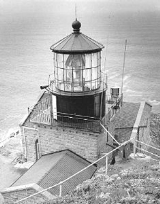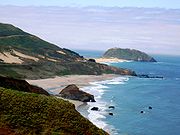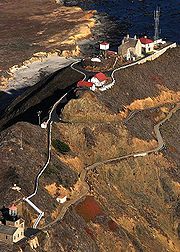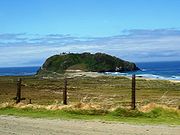
Point Sur Lighthouse
Encyclopedia
Point Sur Lightstation is a lighthouse
at Point Sur, California
, 135 miles (217 km) south of San Francisco, on the 361 feet (110 m)-tall rock at the head of the point. The light house is 40 feet (12 m) tall and 270 feet (82 m) above sea level. It was established in 1889. As of 2010, the light was still in operation as an aid to navigation.
. Many ships were wrecked there.
In 1874, the ship Ventura ran onto rocks just north of Point Sur, and many people died. Though the Venturas captain was drunk, the absence of a light contributed to this tragedy.
The board of the United States Lighthouse Service
(USLS) stated in 1874 that “Point Sur is the most important point and should be the site of a lighthouse. In considering the various points on the California coast where lighthouses are still required, Point Sur claims the place of greatest importance." The board repeated this recommendation, and California citizens submitted petitions in support. In 1885, the board stated that "this dangerous point, which is still unlighted, is made subject of much complaint."
Finally, in 1886, Congress appropriated $50,000 for construction of a lighthouse at Point Sur, and another $50,000 in 1887.
Twenty-five men were employed in the construction of the lighthouse and adjacent buildings. They built a road from the mainland to the rock, blasted a trail to the top of the rock, quarried stone, and built a tramway from the shore to the peak. By the end of the first year, all the rock had been quarried and construction of many buildings was well underway. The Lighthouse Board hoped the construction would be completed by the end of 1888, but an additional $10,000 was needed before the light station was completed and the lantern lit on August 1, 1889. (Point Sur is technically a light station, as opposed to a lighthouse, because it consists of multiple buildings.)
Life on Point Sur was very isolated. The only road, which led to Monterey
, was long and often dangerous. The keepers received goods and bulk supplies by boat roughly every four months. A “lighthouse tender” brought the supplies, but to get them ashore, the supplies were transferred to skiffs and floated to land in barrels.
Highway 1
was completed in 1937, connecting Big Sur
with Monterey to the north and San Luis Obispo
to the south. Prior to the construction of Highway 1, the California coast south of Carmel
and north of San Simeon was one of the most remote regions in the state, rivaling nearly any other region in the United States for its difficult access. Life on the Point Sur became less isolated. The light was automated by the United States Coast Guard
in 1972. The original Fresnel lens was moved to the Maritime Museum
of Monterey, where it is currently on exhibit.
In 1991, the old lighthouse and a 37 acres (15 ha) area was listed on the U.S. National Register of Historic Places
as Point Sur Light Station. In 2004, the Coast Guard transferred the building and land to California Department of Parks and Recreation
.
s occurring off Point Sur:

First, it had an oil wick lamp, and then an oil vapor lamp, Three different fuels, whale oil
, lard
oil, and kerosene
, were used while the oil lamps were in use. Later, two two different kinds of electric lights were used.
The Station emitted a beam of light, which was swept across the arc to seaward of the Point. The lamp's light was concentrated into a beam with a first-order Fresnel lens
. The lens was almost 9 feet (3 m) tall and weighed 4,330 pounds. The entire structure, including the pedestal and clockworks was 18 feet (5 m) tall and weighed 9570 pounds (4,341 kg).

to alert ships. A coal-powered foghorn
was installed when the light was used, but this labor-intensive system was replaced as soon as better technology was available. In 1972, the “Super Tyfon Double Fog Signal,” named after the giant Typhon
from Greek mythology
, was put into use. This system consisted of two compressed air horns sounding simultaneously, and could be heard up to 3 nautical miles (6 km) away. The modern electric tone fog signal was a 12 volt high frequency fog signal with a sound range of half a nautical mile. The high frequency was very effective in fog.
The lighthouse keepers and their families lived in isolation at Point Sur. Therefore the station included all facilities needed for them to be self-sustaining. There was a cistern which held 53000 gal of water (later replaced by a water tower
), and a pump house which brought up water from a well in the sand flats at the base of the rocks.
There was a barn, where horses and cattle were kept. The carpenter and blacksmith shop held supplies for the keepers to do their own construction, since Monterey was a full day's trip away until the 1930s. The lamp tower, oil room, and fog signal room were all combined into one building because of limited space.

. The old lighthouse structure is open to the public. Point Sur is the only complete turn-of-the-20th-century lightstation open to the public in California. Three-hour walking tours guided by volunteers are available on Wednesdays and weekends throughout the year.
Lighthouse
A lighthouse is a tower, building, or other type of structure designed to emit light from a system of lamps and lenses or, in older times, from a fire, and used as an aid to navigation for maritime pilots at sea or on inland waterways....
at Point Sur, California
California
California is a state located on the West Coast of the United States. It is by far the most populous U.S. state, and the third-largest by land area...
, 135 miles (217 km) south of San Francisco, on the 361 feet (110 m)-tall rock at the head of the point. The light house is 40 feet (12 m) tall and 270 feet (82 m) above sea level. It was established in 1889. As of 2010, the light was still in operation as an aid to navigation.
History
Point Sur was a hazard for ships from the first settlement of California, and especially after the great increase in shipping in the mid-19th century, after the California Gold RushCalifornia Gold Rush
The California Gold Rush began on January 24, 1848, when gold was found by James W. Marshall at Sutter's Mill in Coloma, California. The first to hear confirmed information of the gold rush were the people in Oregon, the Sandwich Islands , and Latin America, who were the first to start flocking to...
. Many ships were wrecked there.
In 1874, the ship Ventura ran onto rocks just north of Point Sur, and many people died. Though the Venturas captain was drunk, the absence of a light contributed to this tragedy.
The board of the United States Lighthouse Service
United States Lighthouse Service
The United States Lighthouse Service, also known as the Bureau of Lighthouses, was the agency of the US Federal Government that was responsible for the upkeep and maintenance of all lighthouses in the United States from the time of its creation in 1910 until 1939...
(USLS) stated in 1874 that “Point Sur is the most important point and should be the site of a lighthouse. In considering the various points on the California coast where lighthouses are still required, Point Sur claims the place of greatest importance." The board repeated this recommendation, and California citizens submitted petitions in support. In 1885, the board stated that "this dangerous point, which is still unlighted, is made subject of much complaint."
Finally, in 1886, Congress appropriated $50,000 for construction of a lighthouse at Point Sur, and another $50,000 in 1887.
Twenty-five men were employed in the construction of the lighthouse and adjacent buildings. They built a road from the mainland to the rock, blasted a trail to the top of the rock, quarried stone, and built a tramway from the shore to the peak. By the end of the first year, all the rock had been quarried and construction of many buildings was well underway. The Lighthouse Board hoped the construction would be completed by the end of 1888, but an additional $10,000 was needed before the light station was completed and the lantern lit on August 1, 1889. (Point Sur is technically a light station, as opposed to a lighthouse, because it consists of multiple buildings.)
Life on Point Sur was very isolated. The only road, which led to Monterey
Monterey, California
The City of Monterey in Monterey County is located on Monterey Bay along the Pacific coast in Central California. Monterey lies at an elevation of 26 feet above sea level. As of the 2010 census, the city population was 27,810. Monterey is of historical importance because it was the capital of...
, was long and often dangerous. The keepers received goods and bulk supplies by boat roughly every four months. A “lighthouse tender” brought the supplies, but to get them ashore, the supplies were transferred to skiffs and floated to land in barrels.
Highway 1
California State Route 1
State Route 1 , more often called Highway 1, is a state highway that runs along much of the Pacific coast of the U.S. state of California. It is famous for running along some of the most beautiful coastlines in the world, leading to its designation as an All-American Road.Highway 1 does not run...
was completed in 1937, connecting Big Sur
Big Sur
Big Sur is a sparsely populated region of the Central Coast of California where the Santa Lucia Mountains rise abruptly from the Pacific Ocean. The name "Big Sur" is derived from the original Spanish-language "el sur grande", meaning "the big south", or from "el país grande del sur", "the big...
with Monterey to the north and San Luis Obispo
San Luis Obispo, California
San Luis Obispo is a city in California, located roughly midway between San Francisco and Los Angeles on the Central Coast. Founded in 1772 by Spanish Fr. Junipero Serra, San Luis Obispo is one of California’s oldest communities...
to the south. Prior to the construction of Highway 1, the California coast south of Carmel
Carmel-by-the-Sea, California
Carmel-by-the-Sea, often called simply Carmel, is a small city in Monterey County, California, United States, founded in 1902 and incorporated in 1916. Situated on the Monterey Peninsula, the town is known for its natural scenery and rich artistic history...
and north of San Simeon was one of the most remote regions in the state, rivaling nearly any other region in the United States for its difficult access. Life on the Point Sur became less isolated. The light was automated by the United States Coast Guard
United States Coast Guard
The United States Coast Guard is a branch of the United States Armed Forces and one of the seven U.S. uniformed services. The Coast Guard is a maritime, military, multi-mission service unique among the military branches for having a maritime law enforcement mission and a federal regulatory agency...
in 1972. The original Fresnel lens was moved to the Maritime Museum
Maritime museum
A maritime museum is a museum specializing in the display of objects relating to ships and travel on large bodies of water...
of Monterey, where it is currently on exhibit.
In 1991, the old lighthouse and a 37 acres (15 ha) area was listed on the U.S. National Register of Historic Places
National Register of Historic Places
The National Register of Historic Places is the United States government's official list of districts, sites, buildings, structures, and objects deemed worthy of preservation...
as Point Sur Light Station. In 2004, the Coast Guard transferred the building and land to California Department of Parks and Recreation
California Department of Parks and Recreation
The California Department of Parks and Recreation, also known as California State Parks, manages the California state parks system. The system administers 278 parks and 1.4 million acres , with over of coastline; of lake and river frontage; nearly 15,000 campsites; and of hiking, biking, and...
.
Shipwrecks
Notable shipwreckShipwreck
A shipwreck is what remains of a ship that has wrecked, either sunk or beached. Whatever the cause, a sunken ship or a wrecked ship is a physical example of the event: this explains why the two concepts are often overlapping in English....
s occurring off Point Sur:
- April 20, 1875 - Ventura
- April 22, 1894 - SS Los Angeles (formerly )
- December 5, 1909 - Majestic
- June 29, 1915 - USS H-3USS H-3 (SS-30)USS H-3 was a H-class submarine originally named Garfish, the only ship of the United States Navy named for the garfish, a popular target for recreational anglers....
- October 3, 1915 - Cantania
- July 21, 1916 - Shna-Yak
- September 23, 1921 - G. C. Lindquer
- September 16, 1922 - Thomas Wand
- April 4, 1930, Panama
- March 4, 1923, Babinda
- March 30, 1930, Rhine Maru
- October 27, 1933 - USS ChicagoUSS Chicago (CA-29)USS Chicago was a Northampton-class heavy cruiser of the United States Navy that served in the Pacific Theater in the early years of World War II. She was the second US Navy ship to be named after the city of Chicago, Illinois...
- November 25, 1933 - Lupine
- February 13, 1935 - USS Macon
- May 24, 1946 - Frank Lawrence
- October 24, 1947 - Sparrows Point
- May 14, 1956 - Howard Olsen

The light
The lighthouse has had four different light sources during its history.First, it had an oil wick lamp, and then an oil vapor lamp, Three different fuels, whale oil
Whale oil
Whale oil is the oil obtained from the blubber of various species of whales, particularly the three species of right whale and the bowhead whale prior to the modern era, as well as several other species of baleen whale...
, lard
Lard
Lard is pig fat in both its rendered and unrendered forms. Lard was commonly used in many cuisines as a cooking fat or shortening, or as a spread similar to butter. Its use in contemporary cuisine has diminished because of health concerns posed by its saturated-fat content and its often negative...
oil, and kerosene
Kerosene
Kerosene, sometimes spelled kerosine in scientific and industrial usage, also known as paraffin or paraffin oil in the United Kingdom, Hong Kong, Ireland and South Africa, is a combustible hydrocarbon liquid. The name is derived from Greek keros...
, were used while the oil lamps were in use. Later, two two different kinds of electric lights were used.
The Station emitted a beam of light, which was swept across the arc to seaward of the Point. The lamp's light was concentrated into a beam with a first-order Fresnel lens
Fresnel lens
A Fresnel lens is a type of lens originally developed by French physicist Augustin-Jean Fresnel for lighthouses.The design allows the construction of lenses of large aperture and short focal length without the mass and volume of material that would be required by a lens of conventional design...
. The lens was almost 9 feet (3 m) tall and weighed 4,330 pounds. The entire structure, including the pedestal and clockworks was 18 feet (5 m) tall and weighed 9570 pounds (4,341 kg).

Foghorns
In dense fog, the light beam might not be visible, so the lighthouse had a foghornFoghorn
A foghorn or fog signal or fog bell is a device that uses sound to warn vehicles of hazards or boats of the presence of other vehicles in foggy conditions. The term is most often used in relation to marine transport...
to alert ships. A coal-powered foghorn
Daboll trumpet
A Daboll trumpet is an air trumpet foghorn which had been developed by an American, Celadon Leeds Daboll, of New London, Connecticut. It was basically a small coal-fired hot air engine, which compressed air in a cylinder on top of which was a reed horn....
was installed when the light was used, but this labor-intensive system was replaced as soon as better technology was available. In 1972, the “Super Tyfon Double Fog Signal,” named after the giant Typhon
Typhon
Typhon , also Typhoeus , Typhaon or Typhos was the last son of Gaia, fathered by Tartarus, and the most deadly monster of Greek mythology. He was known as the "Father of all monsters"; his wife Echidna was likewise the "Mother of All Monsters."Typhon was described in pseudo-Apollodorus,...
from Greek mythology
Greek mythology
Greek mythology is the body of myths and legends belonging to the ancient Greeks, concerning their gods and heroes, the nature of the world, and the origins and significance of their own cult and ritual practices. They were a part of religion in ancient Greece...
, was put into use. This system consisted of two compressed air horns sounding simultaneously, and could be heard up to 3 nautical miles (6 km) away. The modern electric tone fog signal was a 12 volt high frequency fog signal with a sound range of half a nautical mile. The high frequency was very effective in fog.
Structures
The staff of the station consisted of a head keeper and three assistant keepers. The families of the keepers lived with them at the station. The Station had a residence for the head keeper and his family, and another for the assistant keepers.The lighthouse keepers and their families lived in isolation at Point Sur. Therefore the station included all facilities needed for them to be self-sustaining. There was a cistern which held 53000 gal of water (later replaced by a water tower
Water tower
A water tower or elevated water tower is a large elevated drinking water storage container constructed to hold a water supply at a height sufficient to pressurize a water distribution system....
), and a pump house which brought up water from a well in the sand flats at the base of the rocks.
There was a barn, where horses and cattle were kept. The carpenter and blacksmith shop held supplies for the keepers to do their own construction, since Monterey was a full day's trip away until the 1930s. The lamp tower, oil room, and fog signal room were all combined into one building because of limited space.

Today
The lightstation is part of Point Sur Lightstation State Historic ParkPoint Sur Lightstation State Historic Park
The Point Sur Lightstation State Historic Park is located on the Big Sur coastline of Monterey County, south of Rio Road in Carmel. It is both a California state park and on the National Register of Historic Places.-History:...
. The old lighthouse structure is open to the public. Point Sur is the only complete turn-of-the-20th-century lightstation open to the public in California. Three-hour walking tours guided by volunteers are available on Wednesdays and weekends throughout the year.
Marine Protected Areas
Point Sur State Marine Reserve and Marine Conservation Area are marine protected areas offshore from Point Sur Lighthouse. Like underwater parks, these marine protected areas help conserve ocean wildlife and marine ecosystems.Sources
- http://www.pointsur.org/
- http://www.parks.ca.gov/default.asp?page_id=565
- Point Sur State Historic Park Brochure, 2000

